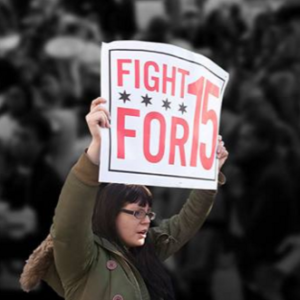The Fight for $15 movement has been highly funded and organized by unions but now it would appear its growing beyond their control.
The Service Employees International Union (SEIU) helped make the movement into an influential political force. The union has put millions into the Fight for $15 since it first started in 2012. Nevertheless, Fight for $15 organizers rallied against the union Friday during its first ever national convention in Richmond, Virginia.
“Even a couple years ago it was clear there was some dissent in the ranks,” Employment Policies Institute Research Director Michael Saltsman told InsideSources. “I think now it has come out into the open in a much more public and embarrassing way.”
Fight for $15 organizers demanded during their convention that they be recognized as employees of the union. Saltsman notes such recognition would be problematic for union leadership. The Fight for $15 would look much less grassroots if movement organizers were considered employees of the union.
“I think when you see the SEIU resisting unionization of these employees, I think what they’re really resisting is, not just the workplace complications that comes along with a unionized workforce, but really the perception that these are employees of the SEIU,” Saltsman stated. “Even though everyone knows in essence they are.”
Saltsman doesn’t believe the union at this point is losing control of the movement as a whole but rather just certain segments. The Fight for $15 has grown rapidly in the last few years meaning the union funds and influence have become stretched. The Campaign for America’s Future (CAF), however, believes it merely shows the movement has been grassroots all along.
“What I would say is that yes, there is a lot of grassroots organizing around Fight for $15 that is independent of any union support,” CAF Spokesman Isaiah Poole told InsideSources. “And that, as I think anyone in Fight for $15 would tell you, this is more a fight that was born among low-wage workers themselves rather than something that was incubated in union office national headquarters.”
The Fight for $15 movement from the beginning was run by union organizers like Kendall Fells. Additionally, the union has put millions of dollars into the movement nearly every year since it started. Critics have contested the movement is merely a scheme to bypass federal law to more easily organize workers.
“The SEIU from the beginning has put together this structure because they want to avoid this perception of this being a top-down campaign that is really just designed to benefit the SEIU’s bottom line,” Saltsman noted. “This allows the SEIU to avoid this accusation from workers of this being a top-down play for more money.”
Saltsman warns the movement cannot survive without union support. The SEIU has spent a lot of money towards public relations firms, research and rallies to help support the movement. America Rising Squared Communications Director Jeremy Adler notes the union is being hypocritical by not recognizing movement organizers as employees.
“Workers have clearly had enough of SEIU’s games and have taken note of their full fledged hypocrisy,” Jeremy told InsideSources. “It’s now apparent that SEIU isn’t concerned about the well-being of its own workers, but about advancing a far-left political agenda and expanding labor’s power.”
America Rising is a nonprofit research group that promotes conservative policies. The SEIU has often touted how beneficial union representation is for workers. Fight for $15 organizers would have the chance to join the Union of Union Representatives if they were considered employees of the SEIU.
The Employment Policies Institute has been critical of what impact the $15 minimum wage will have. The institute has found in its research the policy adversely impacts businesses and decreases employment opportunities. It released an app last week designed to let employers express their concerns about the policy.
The Fight for $15 and the SEIU did not respond to a request for comment by InsideSources.

